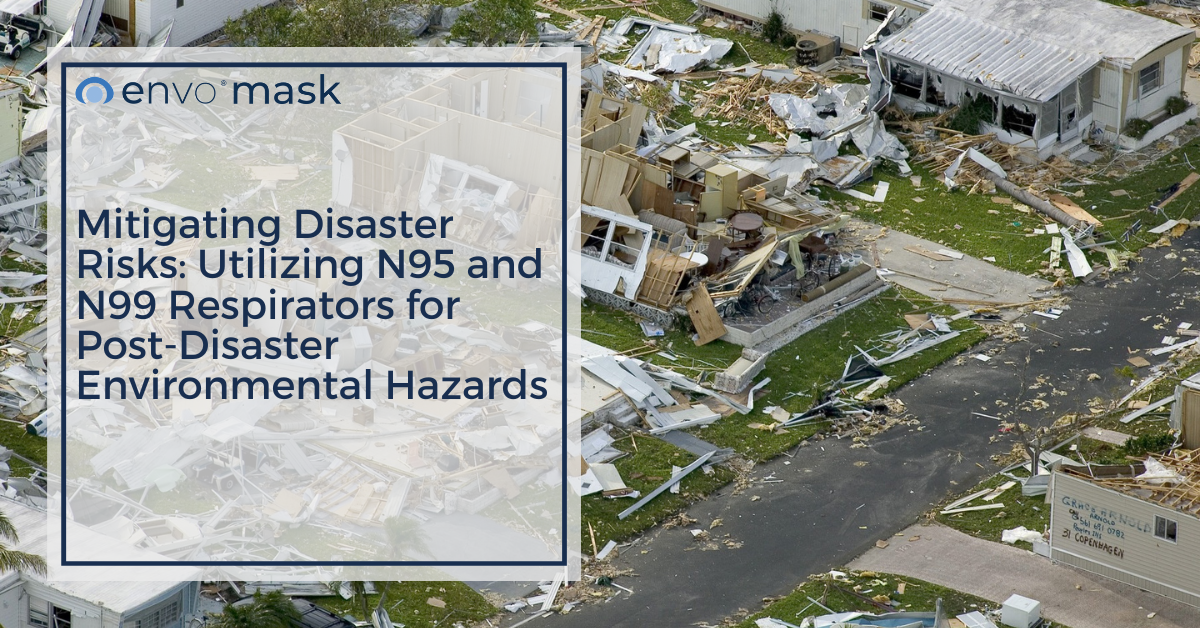Mitigating Disaster Risks: Utilizing N95 and N99 Respirators for Post-Disaster Environmental Hazards
By: Skylar Carr

Photo by Denniz Futalan on Pexels
Disasters such as wildfires, floods, and other catastrophic events often leave behind significant environmental hazards, including mold, airborne contaminants, and toxic particles. In the aftermath of these disasters, it is crucial to prioritize the safety and well-being of individuals involved in disaster mitigation and cleanup efforts. This use case explores the role of N95 and N99 respirators in disaster mitigation after events like wildfires, hurricanes, and floods, focusing on how these respirators protect workers from airborne contaminants, such as ash, dust, and mold spores, and ensure their safety in post-disaster environments.
According to the National Safety Council (NSC), “Preparation for natural disasters such as hurricanes means not only having the right safety procedures in place before a severe event but also having the proper protective equipment for the cleanup afterward. Even after a hurricane has passed and the site has been cleared for reentry, many dangers remain for workers involved in cleanup operations. Planning respiratory protection ahead of time is crucial to help keep workers safe” (National Safety Council. www.nsc.org. Accessed 6/14/2023).
Consider the following scenarios in which an N95 or N99 respirator helps to protect workers during disaster mitigation:
Post-Wildfire Cleanup and Restoration
Following a devastating wildfire, Steve and his disaster response team, deployed by a Federal Government Agency, are confronted with the challenging task of cleaning up and restoring the affected areas. The aftermath of the wildfire resulted in a significant accumulation of ash, debris, and other hazardous materials, necessitating a meticulous cleanup effort to safeguard the well-being of both the community and the workers involved.
To address the potential respiratory risks associated with the cleanup process, Steve and his crew rely on their trusted envo® pro N99 respirators. These respirators serve as a crucial line of defense, protecting them from inhaling harmful airborne contaminants. The envo® pro N99 respirators are specifically designed to offer a high level of filtration efficiency and a secure fit, ensuring the team’s safety by preventing the inhalation of dangerous particles that can lead to respiratory issues.
With their envo® pro N99 respirators in place, Steve and his crew work diligently to clean up the ash and debris left in the aftermath of the wildfire. Knowing that they are shielded from potential health hazards, they confidently carry out their tasks.
Flood Damage Remediation and Mold Mitigation
In the aftermath of a devastating flood that swept through their town, Bill and Janet find themselves in need of professional assistance to restore their home, which suffered significant moisture and water damage. Concerned with the potential for mold growth due to water damage, they decide to bring in a mold remediation specialist to address the issue and protect their health. Understanding the risks associated with exposure to mold spores, Bill and Janet are aware of the importance of taking precautionary measures during the remediation process. They wear envo® pro N99 respirators to ensure their respiratory health and safety. These respirators, known for their high-level filtration capacity, provide Bill and Janet with reliable protection against potentially harmful mold spores present in the air.
Hurricane Cleanup and Decontamination
In the wake of a devastating hurricane that tore through a coastal town, Ecopro, an environmental clean-up company, is confronted with the task of removing and decontaminating hazardous substances left in the hurricane’s aftermath. Disasters like hurricanes can pose significant health risks to those involved in cleanup efforts. Ecopro’s executive management and safety officers understand the importance of protecting their team of workers from potential airborne contaminants that may be present during the removal and disposal process. Equipped with envo® pro N99 respirators, the team creates a crucial layer of defense against harmful airborne particles, ensuring their safety while navigating and performing their duties in these hazardous environments.
Environmental disasters unleash a range of hazards that pose risks to the health and safety of individuals involved in post-disaster mitigation and cleanup efforts. By incorporating N95 or N99 respirators into post-disaster operations, individuals and workers can mitigate health risks and contribute to the safe and effective restoration of affected communities.
Features of the envo® pro: The envo® pro N99 respirator offers superior comfort, fit, and durability. Its patented AIR°gel® cushion technology provides a soft and ergonomic seal, reducing irritation and marks on the skin. The respirator is available in two sizes: regular and extra-large. The envo® pro is designed for long-term wear, making it suitable for extended shifts in challenging environments. One notable feature is its non-fogging capability, which ensures clear vision even when wearing work glasses.
To promote a cooler breathing environment, the envo® pro N99 respirators are equipped with an exhalation valve. This valve facilitates the efficient release of warm air, preventing the buildup of heat and moisture within the respirator. As a result, workers can breathe more comfortably, even in challenging work conditions.
The next level of protection in our line-up of respiratory masks, the envo® pro is a reusable half-face elastomeric respirator certified by NIOSH. Designed to fit most faces, the envo® pro offers additional face coverage while providing secure protection and comfort. Approved for use with either our N95 or N99 filters. Our N99 filters come with a built-in exhalation valve.
By utilizing the envo® pro N99 respirator, individuals can effectively protect themselves from airborne contaminants during disaster mitigation.
